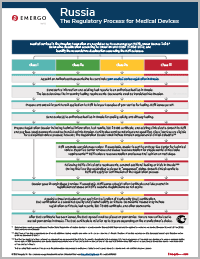Russia Approval Process for Medical Devices

有任何问题?向我们的专家获取相关信息
联系我们To obtain access to the Russian Federation, medical device manufacturers will have to undergo a challenging registration process. Unlike other markets, Russia still requires product testing to be completed even though the device already has US 510(k) clearance or European CE Marking. The agency that oversees this process is the Federal Service for Control over Healthcare and Social Development, more commonly known as “Roszdravnadzor.” For more information on the registration process, download the chart below.
The Russian medical device approval process explained
Step 1:
Medical devices in the Russian Federation are regulated by Roszdravnadzor (RZN), under Decree 1416. Determine classification according to Order 4n and GOST 31508-2012, and identify the nomenclature classification code.
Step 2:
Appoint an Authorized Representative to coordinate your medical device registration in Russia.
Step 3:
Send device information and existing test reports to an authorized test lab in Russia. The lab determines the in-country testing requirements. Documents must be translated into Russian.
Step 4:
Prepare and submit Import Permit application to RZN to import samples of your device for testing. RZN issues permit.
Step 5:
Send device(s) to authorized test lab in Russia for quality, safety, and efficacy testing.
Step 6:
Prepare Registration Dossier including technical information, test results, ISO 13485 certificate, and existing clinical data. Submit to RZN and pay fees. Most documents must be translated into Russian. Certificates must be notarized and apostilled. Class I devices are eligible for a simplified review process; however, the Registration Dossier must include Russian supplemental clinical data*.
Step 7:
For Classes IIa, IIb, and III: RZN conducts completeness review. If acceptable, dossier is sent to an Expertise Center for technical review. Expertise Center reviews and makes recommendation for supplemental clinical data requirements*. RZN reviews recommendation and issues final opinion on next steps.
Step 8:
For Classes IIa, IIb, and III: Following RZN's clinical data requirements, conduct additional testing or trials** in Russia. During this time the registration is placed in "suspended" status. Submit clinical results to RZN and apply for continuation of the registration process.
Step 9:
For all device classes: Dossier goes through Stage 2 review. If acceptable, RZN issues a Registration Certificate and lists product in registration database on RZN's website. Registrations do not expire.
Step 10:
For all device classes: Appoint a Russian Declarant and apply for Declaration of Conformity (DoC) certification. DoC certification is a combined quality and product safety certificate. Documents needed may include Registration certificate, test reports, ISO 13485 certificate, and other documents.
Step 11:
For all device classes: After DoC certificate has been issued, the DoC symbol must be placed on your device. You are now authorized to market your device in Russia. The DoC certificate is valid for up to 3 years depending on the manufacturer's choice.
* Additional clinical data requirements could include additional testing, hospital evaluation, or full scale human trials in Russia. Russian clinical data reports should be developed according to Roszdravnadzor guidance document, Order 2n.
** The Russian market is in flux, and certain elements of the law are not defined. Order 2n provides broad criteria for the types of devices that require a clinical study, e.g., devices with novel or complex medical technologies. If RZN determines your device meets these criteria then clinical studies with human patients will be required. Unfortunately, RZN has not released any guidance document on how to conduct clinical studies in Russia.
This is a simplified overview of the process. Roszdravnadzor may choose to audit your submission and request more documents, which will add time to your approval.
Chart updated: July 2019